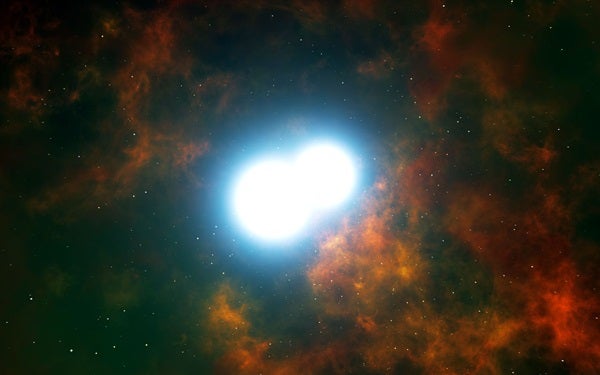More than four decades ago, astronomers discovered the first gamma-ray emission coming from outside the solar system. This high-energy signal is associated with the destruction of roughly 1043 positrons — a type of antimatter — each second. Despite extensive follow-up, astronomers today are still looking for the exact source (or sources) of this emission, which could run the gamut from mundane (natural processes in a star’s life) to exotic (dark matter) origins. Recently, a group of astronomers has determined that positrons resulting from white dwarf mergers could contribute significantly to the signal we see.
The emission associated with galactic positron annihilation occurs when a positron meets its counterpart, an electron, destroying both particles in the process. Thus, this emission requires a ready source of antimatter, which has remained mysterious ever since its initial detection.
Measurements suggest that the signal is nearly one and a half times higher in the bulge, or central regions of the Milky Way, than in the arms. This particular aspect of the emission has led to the development of several models that speculate an overabundance of positrons in this area could be due to processes related to dark matter or our galaxy’s central supermassive black hole. However, many astronomers are still searching for less exotic ways the positrons we’re seeing undergo annihilation could be produced.
In a paper published May 22 in Nature Astronomy, first author Roland M. Crocker of the Research School of Astronomy and Astrophysics at Australian National University and his co-authors examine a possible stellar source of galactic positrons that could be responsible for the signal: white dwarf mergers.
White dwarfs are the remnant cores of Sun-like stars, left behind after the star runs out of fuel and dies. If two low-mass stars (between about 1.4 and 2 times the mass of our Sun) circle each other closely in a binary system, they can interact via a process called mass transfer, where gas from the stars is exchanged. The end result is two white dwarfs that may eventually merge, and that merger can result in the production of radioactive isotopes that decay into positrons.
There are several clues that have led Crocker and his co-authors to this conclusion. The ratio of the signal’s strength in the bulge and arms is similar to the ratio of the stellar mass (essentially the number of stars) in these two structures as well. This led the astronomers to consider that the positron production could be related to an older stellar population, such as white dwarfs. Additionally, by looking at the processes that produce positrons through radioactive decay, they determined that the decay of 44Ti into positrons is the most likely source.
However, this material is not produced in sufficient amounts in most core collapse supernovae, which occur when a massive star reaches the end of its life. While supernovae triggered by the merger of two white dwarfs are much rarer, these events should produce more 44Ti per merger, which would then decay and produce the number of positrons required to create the emission line from their subsequent annihilation.
The current resolution of instruments used to study this emission is not high enough to find point sources, such as individual supernova remnants, in the bulge. Thus, more precise measurements and computer simulations will be needed to determine the positron production rates from such events. The authors also state that white dwarf mergers are likely not the only source of antimatter in our galaxy, which still includes contributions from massive stars and black holes, even if dark matter is eventually ruled out as a viable source for this emission.










